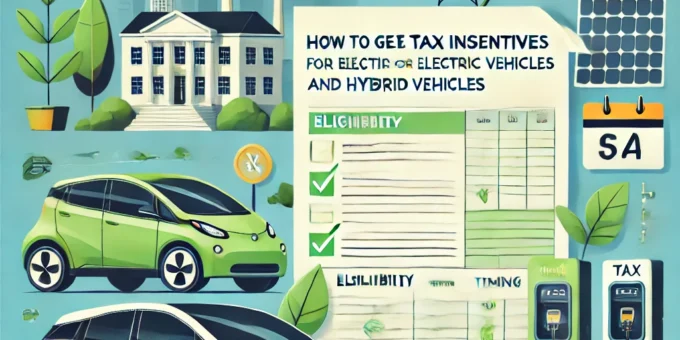
Switching to an electric or hybrid vehicle (EV or HEV) isn’t just good for the environment—it’s also great for your wallet, thanks to generous tax incentives and rebates. Federal, state, and local programs are designed to make eco-friendly vehicles more affordable by offsetting their initial costs. However, navigating these incentives can sometimes feel overwhelming.
This comprehensive guide will walk you through everything you need to know about securing tax incentives for buying an electric or hybrid vehicle, including eligibility criteria, how to apply, and tips to maximize your savings.
What Are Tax Incentives for EVs and Hybrids?
Tax incentives for electric and hybrid vehicles are government programs designed to encourage the adoption of eco-friendly transportation. These incentives aim to offset the higher upfront costs of EVs and HEVs, making them more accessible to the average buyer.
The most common forms of incentives include:
- Federal tax credits.
- State rebates and tax breaks.
- Local utility discounts or free charging credits.
- Additional perks like HOV lane access and reduced registration fees.
By taking advantage of these programs, you can save thousands of dollars on your new vehicle purchase.
Federal Tax Credit for Electric Vehicles
The federal government offers a Clean Vehicle Tax Credit for qualifying EVs and plug-in hybrid electric vehicles (PHEVs). This credit can be worth up to $7,500, depending on the vehicle and the battery size.
Eligibility Criteria
To qualify for the federal EV tax credit:
- The vehicle must have a battery capacity of at least 7 kWh.
- The car must be purchased new from a dealer (used EVs may qualify for separate incentives).
- The final assembly of the vehicle must occur in North America (per the Inflation Reduction Act of 2022).
- Your income must not exceed the set limits ($150,000 for single filers and $300,000 for joint filers).
Pro Tip: Confirm that your EV or hybrid model is eligible by checking the IRS’s updated list of qualifying vehicles.
State and Local EV Incentives
In addition to federal tax credits, many states and cities offer their own EV incentives. Examples include:
- California: Up to $7,500 in state rebates through the Clean Vehicle Rebate Project (CVRP).
- New York: A $2,000 rebate under the Drive Clean Rebate program.
- Colorado: Offers $2,500 in state tax credits for EV purchases.
These programs vary widely, so it’s important to research what’s available in your area.
Utility Company Rebates and Discounts
Some utility companies offer rebates for purchasing or leasing EVs, as well as discounts for installing home charging stations. Examples include:
- Pacific Gas & Electric (PG&E): Offers rebates of up to $800 for new EV buyers.
- Duke Energy: Provides rebates for Level 2 home charger installations.
- Southern California Edison (SCE): Offers a $1,000 rebate for new or used EVs.
Check with your local utility provider for available programs.
How the Federal Tax Credit Works
Here’s a step-by-step guide to claiming the federal EV tax credit:
- Confirm Eligibility: Ensure your vehicle qualifies by checking the IRS list of eligible models.
- Purchase Your EV: Keep your purchase agreement or invoice as proof.
- File IRS Form 8936: Submit this form with your annual tax return to claim the credit.
- Wait for the Credit: The credit reduces your tax liability, but you must owe taxes to take full advantage of it.
Note: The credit is non-refundable, meaning it cannot exceed the amount of taxes you owe.
New Changes Under the Inflation Reduction Act
The Inflation Reduction Act of 2022 introduced updates to the federal EV tax credit:
- Final Assembly Requirement: Eligible vehicles must be assembled in North America.
- Battery Sourcing Rules: A portion of battery components must be sourced from the U.S. or its trade partners.
- Used EV Tax Credit: Buyers of used EVs can now claim a tax credit of up to $4,000.
These changes aim to boost domestic EV production and reduce reliance on foreign supply chains.
Leasing vs. Buying and Tax Incentives
When leasing an EV, the tax credit typically goes to the leasing company, not the lessee. However, many leasing companies pass on the credit to the customer through lower monthly payments.
If you’re buying, you can claim the full federal credit yourself, along with any applicable state or local incentives.
Tax Incentives for Plug-In Hybrid Vehicles
Plug-in hybrid vehicles (PHEVs) are also eligible for tax credits, but the amount depends on battery size. Most PHEVs qualify for credits ranging from $2,500 to $7,500.
Example:
- Toyota Prius Prime: Eligible for up to $4,502 in federal tax credits.
- Ford Escape Plug-In Hybrid: Eligible for up to $6,843.
Maximizing Savings with Stacked Incentives
To maximize your savings, stack federal, state, and local incentives. For example:
- Combine the federal EV tax credit ($7,500) with California’s state rebate ($7,500) and PG&E’s utility rebate ($800) for total savings of $15,800.
- Look for dealerships offering additional discounts or promotions for EV buyers.
FAQs About EV and Hybrid Tax Incentives
Can I claim the federal tax credit for a used EV?
Yes, used EVs purchased after 2023 may qualify for a tax credit of up to $4,000 under new legislation.
Are there income limits for the federal EV tax credit?
Yes, single filers must earn less than $150,000, and joint filers must earn less than $300,000 to qualify.
Do leased EVs qualify for tax credits?
The tax credit goes to the leasing company, but they often pass on the savings through reduced lease payments.
Can I combine multiple state and federal incentives?
Yes, you can stack federal, state, and local incentives to maximize your savings.
Getting tax incentives for buying an electric or hybrid vehicle is a great way to make your eco-friendly investment more affordable. By leveraging federal tax credits, state rebates, and utility discounts, you can significantly reduce the cost of your new car while contributing to a cleaner, greener future.